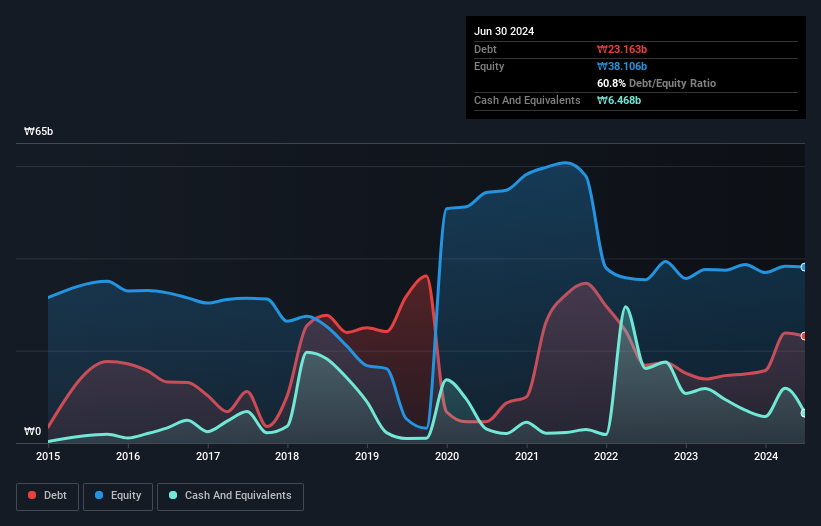- South Korea
- /
- Medical Equipment
- /
- KOSDAQ:A142280
Is Green Cross Medical Science (KOSDAQ:142280) A Risky Investment?

David Iben put it well when he said, 'Volatility is not a risk we care about. What we care about is avoiding the permanent loss of capital.' So it seems the smart money knows that debt - which is usually involved in bankruptcies - is a very important factor, when you assess how risky a company is. We note that Green Cross Medical Science Corporation (KOSDAQ:142280) does have debt on its balance sheet. But is this debt a concern to shareholders?
Why Does Debt Bring Risk?
Debt is a tool to help businesses grow, but if a business is incapable of paying off its lenders, then it exists at their mercy. Part and parcel of capitalism is the process of 'creative destruction' where failed businesses are mercilessly liquidated by their bankers. However, a more usual (but still expensive) situation is where a company must dilute shareholders at a cheap share price simply to get debt under control. Of course, debt can be an important tool in businesses, particularly capital heavy businesses. When we examine debt levels, we first consider both cash and debt levels, together.
Check out our latest analysis for Green Cross Medical Science
How Much Debt Does Green Cross Medical Science Carry?
You can click the graphic below for the historical numbers, but it shows that as of June 2024 Green Cross Medical Science had ₩23.2b of debt, an increase on ₩14.6b, over one year. However, it does have ₩6.47b in cash offsetting this, leading to net debt of about ₩16.7b.

How Healthy Is Green Cross Medical Science's Balance Sheet?
According to the last reported balance sheet, Green Cross Medical Science had liabilities of ₩49.3b due within 12 months, and liabilities of ₩7.95b due beyond 12 months. Offsetting these obligations, it had cash of ₩6.47b as well as receivables valued at ₩22.0b due within 12 months. So its liabilities total ₩28.8b more than the combination of its cash and short-term receivables.
While this might seem like a lot, it is not so bad since Green Cross Medical Science has a market capitalization of ₩93.7b, and so it could probably strengthen its balance sheet by raising capital if it needed to. But it's clear that we should definitely closely examine whether it can manage its debt without dilution.
We measure a company's debt load relative to its earnings power by looking at its net debt divided by its earnings before interest, tax, depreciation, and amortization (EBITDA) and by calculating how easily its earnings before interest and tax (EBIT) cover its interest expense (interest cover). Thus we consider debt relative to earnings both with and without depreciation and amortization expenses.
While Green Cross Medical Science's debt to EBITDA ratio (3.9) suggests that it uses some debt, its interest cover is very weak, at 0.12, suggesting high leverage. In large part that's due to the company's significant depreciation and amortisation charges, which arguably mean its EBITDA is a very generous measure of earnings, and its debt may be more of a burden than it first appears. So shareholders should probably be aware that interest expenses appear to have really impacted the business lately. One redeeming factor for Green Cross Medical Science is that it turned last year's EBIT loss into a gain of ₩370m, over the last twelve months. There's no doubt that we learn most about debt from the balance sheet. But it is Green Cross Medical Science's earnings that will influence how the balance sheet holds up in the future. So when considering debt, it's definitely worth looking at the earnings trend. Click here for an interactive snapshot.
But our final consideration is also important, because a company cannot pay debt with paper profits; it needs cold hard cash. So it's worth checking how much of the earnings before interest and tax (EBIT) is backed by free cash flow. Over the last year, Green Cross Medical Science saw substantial negative free cash flow, in total. While that may be a result of expenditure for growth, it does make the debt far more risky.
Our View
To be frank both Green Cross Medical Science's interest cover and its track record of converting EBIT to free cash flow make us rather uncomfortable with its debt levels. But at least its EBIT growth rate is not so bad. We should also note that Medical Equipment industry companies like Green Cross Medical Science commonly do use debt without problems. Looking at the balance sheet and taking into account all these factors, we do believe that debt is making Green Cross Medical Science stock a bit risky. That's not necessarily a bad thing, but we'd generally feel more comfortable with less leverage. When analysing debt levels, the balance sheet is the obvious place to start. But ultimately, every company can contain risks that exist outside of the balance sheet. For example Green Cross Medical Science has 4 warning signs (and 2 which are potentially serious) we think you should know about.
If you're interested in investing in businesses that can grow profits without the burden of debt, then check out this free list of growing businesses that have net cash on the balance sheet.
New: Manage All Your Stock Portfolios in One Place
We've created the ultimate portfolio companion for stock investors, and it's free.
• Connect an unlimited number of Portfolios and see your total in one currency
• Be alerted to new Warning Signs or Risks via email or mobile
• Track the Fair Value of your stocks
Have feedback on this article? Concerned about the content? Get in touch with us directly. Alternatively, email editorial-team (at) simplywallst.com.
This article by Simply Wall St is general in nature. We provide commentary based on historical data and analyst forecasts only using an unbiased methodology and our articles are not intended to be financial advice. It does not constitute a recommendation to buy or sell any stock, and does not take account of your objectives, or your financial situation. We aim to bring you long-term focused analysis driven by fundamental data. Note that our analysis may not factor in the latest price-sensitive company announcements or qualitative material. Simply Wall St has no position in any stocks mentioned.
About KOSDAQ:A142280
Green Cross Medical Science
Manufactures and sells diagnostic reagents and medical devices in South Korea and internationally.
Proven track record with adequate balance sheet.
Market Insights
Community Narratives



